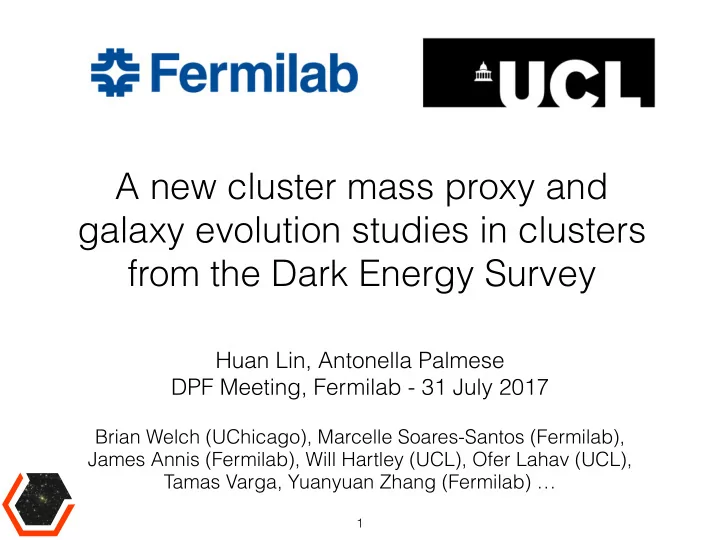

A new cluster mass proxy and galaxy evolution studies in clusters from the Dark Energy Survey Huan Lin, Antonella Palmese DPF Meeting, Fermilab - 31 July 2017 Brian Welch (UChicago), Marcelle Soares-Santos (Fermilab), James Annis (Fermilab), Will Hartley (UCL), Ofer Lahav (UCL), Tamas Varga, Yuanyuan Zhang (Fermilab) … 1
Introduction • Voronoi Tessellation cluster finder (Soares-Santos et al. 2011): 2D tessellation in photometric redshift shells • VT mass proxy shows high scatter in richness- (Saro et al. 2015) - important for cluster cosmology! • Develop a new mass proxy for VT, that is not red-sequence based • Mass proxy based on cluster galaxies stellar masses • All results are unpublished and preliminary • Stellar mass is a good mass proxy for halo mass • It can be reliably estimated with DES data within clusters (Palmese et al. 2016) 2
Clusters sample • Results showed here: redMaPPer Year 1 clusters. • VT cluster catalogs under production for DES and BLISS • redMaPPer is a cluster finder that RXJ2248.7–4431 identifies clusters by means of the red sequence • cosmology sample: lambda>5, volume limited, ~87k clusters, up to z~0.7 • full sample: lambda>20, ~8000 Rykoff et al. 2016 clusters up to z~1 3
Membership assignment and photometric properties of DES redMaPPer clusters • Year 1 redMaPPer cluster center and redshift • Select galaxies from the Year 1 galaxy catalog • Assign redshift (from photoz), radial and color membership probability • Halo Occupation Distribution model for M 200 and R 200 assignment • Gaussian Mixture Modeling for red sequence and blue cloud • RS color, width and slope measurement for ~8000 clusters out to z~1 For more information: 4
Bayesian Model Averaging for galaxy stellar mass COSMOS galaxies • FSPS (Conroy and Gunn 2010) synthetic models • Padova 1994 isochrones, Chabrier IMF, Simha et al. SFH, 4 metallicities+ low metallicity addition • Bayesian model averaging for M * estimation Millennium simulations clusters • Validation with Y1 data against other surveys, methods and simulations 5
Calibrating against other mass observables • XMM sample: ~200 clusters matching redMaPPer Y1, Chandra sample: ~90 clusters • Bayesian linear regression • Inclusion of the blue cloud does not increase the intrinsic scatter • Optimization of the radius: P rad works well • Tests on Millennium simulations also show promising scatter results • Mass calibration on SDSS redMaPPer and VT clusters (Pereira et. al 2017, in prep.) 6
Stellar fractions and SHMR Simulations and observations still mostly in tension Arthur et al. 2017 Some codes Over-production agree with of stars observations at in non-AGN high mass codes Star formation efficiency peaks around Milky way-like masses
Stellar to halo mass relation Study whole Y1 redmapper by using lambda-mass relation from weak lensing calibration (Melchior et al., 2016) for an independent estimate of the halo mass • Motivation: tensions between simulations and observations • Measurement on huge sample compared to other results • Cosmology sample • Provide fits SHMR for total, central, satellites Power law fit • Consistent with other predictions/ for centrals measurements 8
Stellar to halo mass relation • Asymptotic total stellar mass fraction of ~1% • Central contributes to ~20% of the total stellar mass • Satellites show a steeper and tighter correlation with halo mass • Satellites 60-90% of total stellar mass around M 500 ~10 14 , >80% around 10 15 M_Sun 9
Central mass growth Corrected for central-halo mass correlation by dividing for halo mass • Halo mass evolved up to z=0 • Growth of factor ~4 consistent with semi-analytical models (De Lucia+07) • If evolution is not taken into account, growth ~2 (Lidman +12) • ICL makes up 20-40% of the total cluster stellar mass. We want to estimate its contribution for DES clusters (ICL detection by Yuanyuan) • Log-normal mass function of centrals 10
BCG or central? BCG and central galaxy are not (always) the same object • ~20% of centrals are not the redMaPPer central most massive cluster galaxy as center (MMCG) in stellar mass, ~30% are not the BCG • MMCG is a better proxy of central than BCG • MMCG is a good proxy of the center of a cluster also Chandra X-ray when compared to X-ray center centroids. 11
Conclusions • Promising new mass proxy: low (0.2) scatter in mu-T X relation and in mu-mass relation from simulations. Weak lensing calibration on SDSS (close to publication) and on DES Y1 (ongoing) • Working on DES Y1 weak lensing calibration • Interesting observable for cluster/galaxy evolution studies: star formation efficiency, blue fraction evolution.. • Working on SFRs, systematics • Palmese et al. and Welch et al. papers in preparation 12
Total star formation rates Evolution of the total SFRs of clusters per unit halo mass • Understand quenching and Butcher-Oemler effect • Total SFR per unit halo mass • No significant redshift evolution • Differences: use LIR, PRELIMINARY correct for low luminosity galaxies, 9 clusters • Other works show no increase/slower increase (Behroozi+10) • Sample selection problem 13
Recommend
More recommend